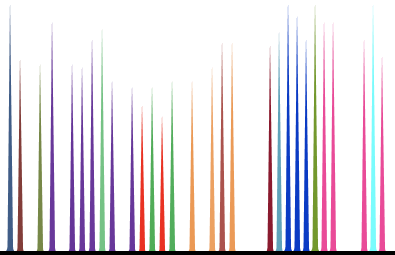Mass Cytometry
We analyze over 600 immune subsets and functional states using mass cytometry
Mass Cytometry is a technology used to determine specific properties of cells.
It is an advanced cytometry method that builds upon the established science of flow cytometry while eliminating many of the common challenges associated with the technique.
Armed with in-depth immune information, researchers can make informed decisions around patient response and drive new pathway discoveries.

Mass vs. Flow Cytometry
Mass Cytometry is a technology used to determine specific properties of cells.
It is an advanced cytometry method that builds upon the established science of flow cytometry while eliminating many of the common challenges associated with the technique.
Armed with in-depth immune information, researchers can make informed decisions around patient response and drive new pathway discoveries.

Flow Cytometry
- 10-15 markers per assay
- Significant signal overlap
- Multiple sample consumption for result
- High marker redundancy across panels

MASS Cytometry
- Up to 45 unique markers per assay
- High-resolution, minimal signature overlap
- Single sample consumption for result
- Single, optimized panel without marker redundancy
Expertly Designed Human Pan-Immune Panel (Standard)
The TokuProfile Standard Human Pan-Immune panel includes:
- Markers to identify every major immune cell population and subsets
- Expression of key co-stimulatory and co-inhibitory molecules that regulate cell function
- Markers of recent activation and effector function
-
T cells
- CD3
- Total T cells
- CD4
- CD4+ T cells
- CD8a
- CD8+ T cells
- CD27
- Maturation
- CD45RA
- Naive/Memory
- CCR7 (CD197)
- Naive/Memory
- Foxp3
- Treg
- CD25
- Treg, activation
- CD127
- T cell subsets
- T-bet
- T cell subsets
- CD38
- Maturation
- CD69
- Early Activation
- HLA-DR
- Activation
- TCF1
- Stemness
- CD7
- T cell subsets
- CD56
- NKT, T cell subsets
- gdTCR
- gdT cells
- CTLA-4 (CD152)
- Checkpoint
- PD-1
- Checkpoint
- TIM-3
- Checkpoint
- TIGIT
- Checkpoint
- LAG3
- Checkpoint
- CD57
- Senescence
- KLRG-1
- Senescence
- Granzyme B
- Effector
- CD95
- Stem cell memory
- CD39
- Tumor specific
- CD28
- Co-stimulation, Maturation
- CD161
- Inhibitory Receptor
- ICOS
- Checkpoint
-
B cells
- CD19
- Total B cells
- CD25
- Activation
- CD27
- Naive/Memory
- CD38
- Naive/Memory
- HLA-DR
- Antigen presentation
- CD74
- Survival
-
NK cells
- CD56
- NK cell subsets
- CD16
- NK cell subsets
- CD8a
- NK cell subsets
- CD7
- NK cell subsets
- CD38
- Activation
- T-bet
- Maturation
- Granzyme B
- Effector
-
Myeloid cells
- CD11b
- Monocytes, macrophages
- CD11c
- Monocytes, macrophages, DCs
- CD14
- Monocyte subsets, Macrophages
- CD16
- Monocyte subsets
- CD33
- Total myeloid
- CD123
- pDC
- PD-L1
- Checkpoint ligand
- HLA-DR
- Antigen presentation
- CD86
- Activation
- CD74
- Survival
- LOX-1
- PMN-MDSCs
-
Granulocytes
Whole blood only- CD66b
- Granulocytes
- CD11b
- Neutrophils
- CD16
- Neutrophils
- CD15
- Neutrophils
- CD123
- Basophils
-
General
- CD45
- Total immune cells
- KI67
- Proliferation
- CD61
- Platelets
- CD235ab
- Erythrocytes
- DNA
- Singlets
- Live/Dead
- Viability
- IgG4
- Nivo/Pembro
Panel customization
We offer 44-marker customizable human, non-human primate, and mouse panels
Turning Data into Insights

CLIA Validation Data
Mass Cytometry Assay for Pan-Immune Profiling of PBMCsFill out the form below to access our CLIA Validation plan, report, and data and SOPs.